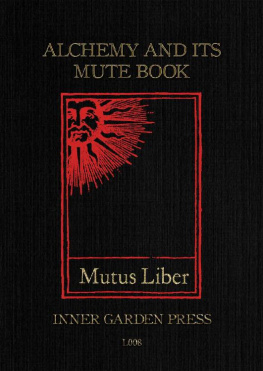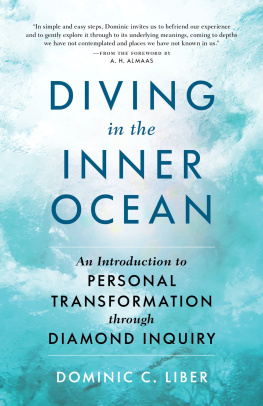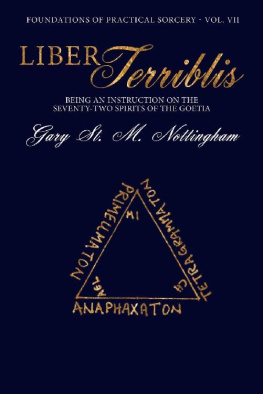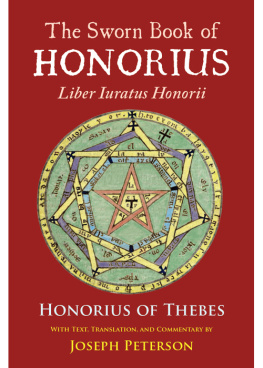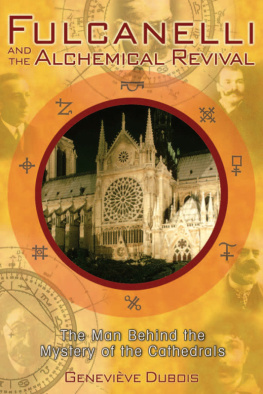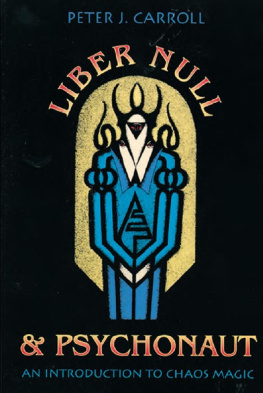ALCHEMY AND ITS
MUTE BOOK
[Mutus Liber]
Introduction and comments by:
Eugne Canseliet F.C.H.
Disciple of Fulcanelli

Inner Garden Press
L008
Translated by T. Bruemmer for Inner Garden Press
Published by Inner Garden Press
2015, Utrecht, the Netherlands
ISBN: 978-94-6163-012-4 (E-book) ISBN: 978-94-6163-016-2 (Hardback)
Copyright Inner Garden Press All rights reserved. No part of this publication may be reproduced, stored in a retrieval system or transmitted, in any form or by any means, electronic, mechanical, photocopy, recording or otherwise, without the prior permission of Inner Garden Press. A catalogue record for this book is available from the National Library, The Netherlands.
Inner Garden Foundation The Inner Garden Foundation conducts research on traditional and modern forms of Alchemy and aims to propagate and pass on the Alchemical Tradition in the broadest sense. For more information refer to: www.innergarden.org |
Original French Edition
LAlchimie et son Livre Muet
[Mutus liber]
Rimpression premire et intgrale
de ldition originale de La Rochelle 1677
Introduction et commentaires par Eugne Canseliet F.C.H.
disciple de Fulcanelli
Paris
chez Jean-Jacques Pauvert
1967
EDITORS PREFACE
In 2010 the Inner Garden Press presented an English translation of Magophons erudite commentary to the Mutus Liber. This year, 2015, after having celebrated our first lustrum, we are proud to present another commentary to the Mutus, one that followed half a century after that of Magophons.
This commentary was written by Eugne Canseliet and bears the title Alchemy and its Mute Book. It concerns an exegesis that is extraordinary in terms of both its content and its style. Canseliets diction is unique and his writing style could be described as a sophisticated form of logographic acupuncture. He delicately examines one location, then carefully touches upon another and before the point has quite sunk in, he has already switched to a different area to carefully place another illustrative needle. Canseliet writes: It is a fact that it was the custom, if not the rule, among ancient authors to write their treatises in such a way that all parts of teaching were scattered and jumbled around, like the disconnected pieces of a puzzle that one must apply oneself to in order to reunite them. As the reader will discover, Canseliet faithfully continues this tradition and delivers his pinpricks in an almost random manner.
At first this may lead the reader to a state of bewilderment about the gist of the story and the overarching aim of Canseliets delicate observations on the imagery. Slowly but surely though, the treatment starts to have its effect. Gradually the meaning of alchemys web of images and symbols starts to seep out of the woodwork and the more experienced student of alchemy will appreciate the sincerity with which Canseliet wrote.
Whereas the existence of this language of images may have seemed unlikely at first, and their meanings far-fetched, this book slowly warms the reader up to this evolved and noble language that was spoken by so many respected authors. And as one warms up to the idea of this language of images, the reality of a most outrageous concept the existence of the Philosophers Stone, the essential subject of the Mutus Liber may gradually appear less of a vain chimera.
In this first quarter of the 21st century we find ourselves at a point in time where information is available instantly, explicitly and profusely and where the exclusion of words goes no further than the placement of an X in X-factor, an E in a digital facility or an I in something marketed as an indispensable personal app that provides the user with immediate information and all manner of facilities. Within the current constellation of immediate gratification, a book such as the Mutus would be quickly cast aside as impenetrable by any sane-minded person had it not been for the existence of a number of guiding lights on the path who, speaking to us from a bygone age, have taken the time and trouble to carefully study and illuminate this work. These guides are, first and foremost, the previously mentioned Magaphon (Pierre Dujols, to whom we owe the first published commentary on the Mutus Liber) as well as to the author of this present book, Eugne Canseliet.
In addition to the work from Canseliet two other commentaries on the Mutus appeared in the second half of the 20th century, one by the hand of Serge Hutin and another by Jean Laplace. The work of Canseliet, however, stands head and shoulders above the other two. The work of Hutin relies all too heavily on quotations from Magophons foundational work and that of Laplace in turn relies on the work of Canseliet. The reader therefore now has in his or her hands the most profound commentary on the Mutus Liber; a commentary of a book that is considered one of the finest examples in the tradition of the wordless book and which lends itself to multiple layers of analysis that go well beyond propositional knowledge.
Could it be that in the footsteps of the guides mentioned above that there yet exists a rare breed of practitioners, and an even rarer class of masters, who still transmit their intimate knowledge of the Mutus Liber? A knowledge which goes beyond even that which is found in this book, unravelling the innermost secrets of the deepest layers of information that make up the very weft of this book? Of which the short puzzle that Canseliet attempted to solve for us that of Oculatus Abis being an anagram of Jacob Sulat is merely a postlude? Could that be the reason why Canseliet refers to this treatise as an introduction, in other words something that is far from a comprehensive discourse on the Mutus? It is best not to venture into subjects that cannot be substantiated, especially not when it concerns such a profound matter as the making of the Philosophers Stone.
Did The Mute Book help Canseliet to achieve this ultimate stage of success? Did he complete the Opus Major that results in the Philosophers Stone? This is another matter that can neither be confirmed nor denied as it remains uncertain whether Canseliet completed the Great Work in the physical realm. There is no known evidence or reason to assume that he was able to fulfil this lifelong passion. Allegedly Canseliet ran into insurmountable difficulties in the final chapter of the work and eventually even became doubtful as to whether he had correctly interpreted the hints given by his master as to the Prima Materia of the work. On the other hand, it is said that Eugne Canseliet did perform a successful transmutation. In a laboratory of the gas works of Sarcelles at the Georgi Company and in the presence of Julien Champagne and Gaston Sauvage, Canseliet reportedly transmuted 100 grams of lead into gold. As the story goes, however, the projection powder that was used for this transmutation was not of Canseliets own making but had been given to him by his teacher. This teacher was the elusive immortal master Fulcanelli who, in his late seventies, had accepted the young Canseliet as his student. In the preface to the book Voyages in Kaleidoscope, one can find a number of hints about the possible real life person behind the pseudonym of Fulcanelli and those who wished to pose as the mysterious Alchemist. Canseliets respect for his master shows throughout his works. Allegedly there was a period in which Canseliet was not the only student of Fulcanelli, even though he was most likely the first and certainly the most dedicated student. Fulcanelli is said to have accepted the sons of Ferdinand de Lesseps as students around 1921 and two more students in the following year, namely Jules Boucher and Gaston Sauvage. Canseliet, however, was the only student who faithfully used the honorary title of F.C.H. behind his name. This abbreviation of
Next page
